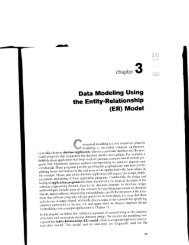13.1 through 13.5, 13.10 and 13.11
13.1 through 13.5, 13.10 and 13.11
13.1 through 13.5, 13.10 and 13.11
You also want an ePaper? Increase the reach of your titles
YUMPU automatically turns print PDFs into web optimized ePapers that Google loves.
Chapter 13 Disk Storage, Basic File Structures, <strong>and</strong> Hashing<strong>13.1</strong>0.3 RAID Organizations <strong>and</strong> LevelsDifferent RAID organizations were defined based on different combinations of thetwo factors of granularity of data interleaving (striping) <strong>and</strong> pattern used to computeredundant infbrmation. In the initial proposal, levels I <strong>through</strong> 5 of RAIDwere proposed, <strong>and</strong> two additional levels-O <strong>and</strong> 6-were added later.RAID level 0 uses data striping, has no redundant data <strong>and</strong> hence has the best writeperformance since updates do not have to be duplicated. IJowever, its read performanceis not as good as RAID level l, which uses mirrored disks. In the latter, performanceimprovement is possible by scheduling a read request to the disk withshortest expected seek <strong>and</strong> rotatior-ral delay. RAID level 2 uses memory-style redundancyby using Hamming codes, which contain parity bits fbr distinct overlappingsubsets of components. Thus, in one particular version of this level, three redundantdisks suffice for four original disks whereas, with mirroring-as in level l-fourwould be required. Level 2 includes both error detection <strong>and</strong> correction, althoughdetection is generally not required because broken disks identily themselves.RAID level 3 uses a single parity disk relying on the disk controller to figure outwhich disk has failed. Levels 4 ancl 5 use block-level data striping, with level 5 distributingdata <strong>and</strong> parity information across all disks. Finally, RAID levei 6 appliesthe so-cirlled P + Q redundancy scheme using Reed-Soloman codes to Protectagainst up to two disk failures by using just trvo redundant disks. The seven RAIDlevels (0 <strong>through</strong> 6) are illustrated in Figure <strong>13.1</strong>3 schematically.Rebuilding in case of disk failure is eirsiest for RAID level l. Other levels require thereconstruction of a failed disk bv reading multiple disks. Level I is used for criticalapplications such as storing logs oftransactions. Levels 3 <strong>and</strong> 5 are preferred for largevolume storage, with level 3 providing higher transf'erates. Most popular use ofRAID technology currently uses level 0 (with striping), level I (with mirroring) <strong>and</strong>level 5 rvith an extra drive for parity. Designers of a RAID setup for a given applicationmix have to confront many design decisions such as the level of ItAlD, the numberof disks, the choice of parity schemes, <strong>and</strong> grouping of disks for block-levelstriping. Detailed performance studies on srnall reads <strong>and</strong> writes (referring to I/Orequests for one striping unit) <strong>and</strong> large reads arnd writes (rel'erring to I/O requests forone stripe unit from each disk in an error-correction grouP) have been performed.<strong>13.1</strong>1 New Storage SystemsIn this section, we describe two recent developments in storage systems that arebecoming an integral part of most enterprise's information system architectures.<strong>13.1</strong>1.1 Storage Area NetworksWith the rapid growth of electronic commerce, Enterprise Resource Planning(ERP) systems that integrate application data across organizations, <strong>and</strong> data warehousesthat keep historical aggregate information (see Chapter 27),the dem<strong>and</strong> for














